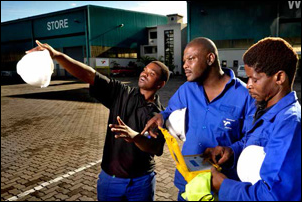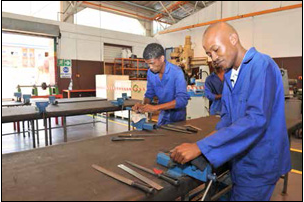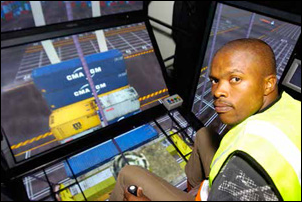From a virtually bankrupt state to a thriving trillion rand budget, South Africa’s economy is undoubtedly a world away from what it was 20 years ago.
A declining employment rate, low investment levels, a poorly educated workforce and large monopolies - these were the features that characterised the South African economy in the period leading to 1994.
 Despite the apartheid government’s efforts to hide all its human rights abuses from the international community, the 1990s saw investors and trade partners pulling out of South Africa in numbers.
Despite the apartheid government’s efforts to hide all its human rights abuses from the international community, the 1990s saw investors and trade partners pulling out of South Africa in numbers.
With devastating internal revolt, sanctions and economic isolation in the lead up to the 1994 historic elections, it was a forgone conclusion that the first democratic government of South Africa was to inherit an economy in crisis.
And that is exactly what happened when the late former President Nelson Mandela was inaugurated as the country’s first democratic president.
According to the Twenty Year Review, the economy grew by just over 1 per cent a year between 1980 and 1994. The poor state of the economy was inevitably going to be a huge challenge for any government that had to meet the expectations of millions of people who were marginalised for over three centuries.
Looking back at 1994, it’s hard to believe how much South Africa’s economy has grown.
Today, millions of South Africans have jobs and are able to access basic services such as water and sanitation and social grants are reaching about 16 million people in need of assistance.
South Africa is now ranked by the World Bank as an “upper middle-income country” and has earned its position as the largest economy in Africa. The review reveals that by 2012, the GDP had reached US$ 384 billion (about R4.1 trillion) compared to the US$ 136 billion in 1994 (about R 1.4 trillion).
Recovery in investment
 The review attributes growth and strength in the South African economy to the reconfiguration of institutions such as South African Revenue Services, the South African Reserve Bank, the Competition Commission and the National Economic Development and Labour Council. South Africa emerged from the pre- 94 economic crisis to attain macro-economic stability – a key achievement of the democratic government.
The review attributes growth and strength in the South African economy to the reconfiguration of institutions such as South African Revenue Services, the South African Reserve Bank, the Competition Commission and the National Economic Development and Labour Council. South Africa emerged from the pre- 94 economic crisis to attain macro-economic stability – a key achievement of the democratic government.
The review notes that work done under the three democratic administrations from that of President Mandela, his successor President Thabo Mbeki to President Zuma – saw the South African economy grow at 3.2 per cent a year on average from 1994 to 2012.
There were only four quarters of negative growth between 1994 and 2012, a far lower rate than in the years before democracy.
While investment must be between 20 per cent and 25 per cent of GDP to sustain growth, it went up from 15 per cent in 1993 to reach 24.8 per cent of GDP in the fourth quarter of 2008 – just before the recession.
Economic policies
The review notes that the new administration in 1994 had to adopt certain policies aimed at stabilising and transforming the economy.
Policy documents included the Ready to Govern and Reconstruction and Development Programme, both aimed at tackling the triple threats to the economy – unemployment, poverty and inequality.
The RDP aimed to address socio-economic needs and restore dignity to the poor.
This programme was aimed at the immediate needs of the people – from the provision of housing, distribution of clean water, electrification of communities, social infrastructure like health care and land reform, among others.
But authorities said that would not be enough to redress the decades-long structural inequalities that apartheid and its laws had created. Government had to introduce the Black Economic Empowerment (BEE) programme to allow more black people to be players in the mainstream economy.
BEE has since been expanded to Broad-Based Black Economic Empowerment to introduce interventions that would promote employment preference, skills development, ownership, management, socio-economic development and preferential procurement.
Looking ahead
 The National Development Plan, supported by the New Growth Path and the Industrial Policy Action Plan, sets out what still needs to be done to achieve sustainable economic transformation. Key actions include:
The National Development Plan, supported by the New Growth Path and the Industrial Policy Action Plan, sets out what still needs to be done to achieve sustainable economic transformation. Key actions include:
- Maintaining large-scale but sustainable public investment in infrastructure to facilitate economic growth, with improved maintenance and a well-defined financing strategy.
- Improving the quality of basic education and expanding higher and further education, linked to stronger ties between enterprises and Further Education and Training in particular, to provide the skills required by a growing economy.
- Ensuring that regulations are implemented as efficiently and cost-effectively as possible, without imposing unnecessary delays or red tape to create a businessfriendly environment.
- Continuing to increase financing for industrial development and small and micro enterprise in the context of a strong industrial policy focused on bolstering employment and growth.
- Improving energy security including through development of shale gas, while continuing to take advantage of opportunities and minimise the costs from greening the economy.
- Enhancing regional development through increased investment in logistics, combined with the establishment of regional value chains, to facilitate regional economic growth and integration.
- Stronger measures to address workplace conflict by working with stakeholders to address unfair inequalities and improve communication and career development to create a more stable workplace environment for growth.
The NDP further states that it is only through effective partnerships across society that a good cycle of rising confidence, rising investment, higher employment, and increased productivity and income can be achieved.
This requires greater trust between the state, labour and business.



 Facebook
Facebook Twitter
Twitter WhatsApp
WhatsApp